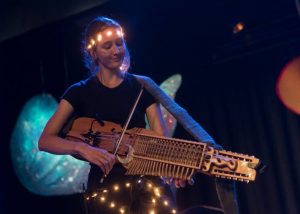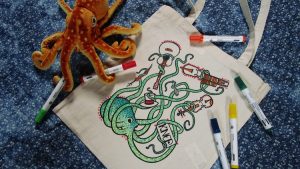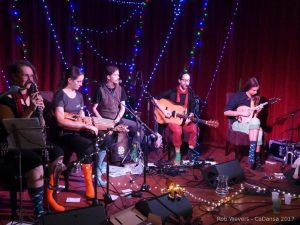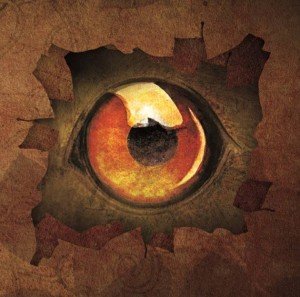KNEP is a young Swiss duo formed by Emilie Waldken and Pascal Rüegger. Their first CD, Bestioles, is a beautiful piece of traditional Scandinavian folk music, with a lovely pure, natural feel to it. Promoting the music they both fell in love with in a beautiful way. The CD came out early 2016. So it’s high time we finally introduce KNEP properly. Starting with a cheerful Emilie.
 Emilie Waldken (EW): ‘Hey CeltCast. Thanks for your interest! Who am I and what is my background? Well, I held a violin as early as I can remember. learning classical music at first. Then specializing more into baroque and growing a strong interest in folk music over the years. First I started to pick up some Celtic and medieval favorites by ear. Eventually, I discovered the nyckelharpa and Swedish folk music. Love at first sight with both! After some years of playing folk music on my own and getting my Certificate in classical violin, I went to Sweden to study nyckelharpa, Scandinavian fiddle and Nordic tradition with masters. Two years which left me being totally passionate about the subject.’
Emilie Waldken (EW): ‘Hey CeltCast. Thanks for your interest! Who am I and what is my background? Well, I held a violin as early as I can remember. learning classical music at first. Then specializing more into baroque and growing a strong interest in folk music over the years. First I started to pick up some Celtic and medieval favorites by ear. Eventually, I discovered the nyckelharpa and Swedish folk music. Love at first sight with both! After some years of playing folk music on my own and getting my Certificate in classical violin, I went to Sweden to study nyckelharpa, Scandinavian fiddle and Nordic tradition with masters. Two years which left me being totally passionate about the subject.’
What would be your favourite instrument?
EW: ‘Hard one! I’d say nyckelharpa of course, although fiddle and its relatives like viola d’amore, hardingfele and viola da gamba I love as much. Oh and I have a total fascination for cello.’
And Pascal? Are you also classicly trained?
Pascal Rüegger (PR): ‘No, I started making music at age 6 with violin. I didn’t stick to it for a long time though and switched to guitar and drums. Soon I started to mess around with a lot of different instruments (singing, piano, percussion, saxophone, cello, mandolin…).
 At some point I did a Bachelor and a Master in jazz on electric bass and double bass, which is probably where a good bit of my approach to music comes from. That is also where I got most of my musical training, so I’d say I’m “jazz trained”, though I have also been playing some classical music as well. I somehow ended up getting more and more into Celtic- and then Scandinavian folk during my studies, which now is kind of my main focus.
The instruments I currently play seriously are guitar, Irish flute, double bass, percussion and mandolin. And I’m definitely not able to pick a favorite.’
At some point I did a Bachelor and a Master in jazz on electric bass and double bass, which is probably where a good bit of my approach to music comes from. That is also where I got most of my musical training, so I’d say I’m “jazz trained”, though I have also been playing some classical music as well. I somehow ended up getting more and more into Celtic- and then Scandinavian folk during my studies, which now is kind of my main focus.
The instruments I currently play seriously are guitar, Irish flute, double bass, percussion and mandolin. And I’m definitely not able to pick a favorite.’
How did KNEP start as a duo?
EW: ‘It was a bit before I went to Sweden that Pascal and me met during a balfolk ball. First we jammed, slowly a common repertoire was created, until one day we stepped on stage. KNEP was born. So KNEP is really a classically-trained fiddler having a passion for nyckelharpa, who met a jazz guitar and bass player, and them ending up in a duo!
We like to stick to the Scandinavian style, using the tradition we both studied as much as possible, and then to expand it with our backgrounds (baroque & jazz) and follow the inspiration we get from the vivid folk music scene in Sweden: modern, passionate, crazy and wonderful.(Pascal also went to Sweden to study the folk tradition, although his focus was more on dancing).
So, in short, we met in Switzerland, then both went to Sweden to study Scandinavian folk music, and then both came back to Switzerland. KNEP went on playing during all that time.’
By the way, what does ‘KNEP’ mean?
EW: ‘KNEP’ was chosen as a name because we wanted a Swedish word, that German-, French- and English-speaking people can pronounce without problem. Also something short and easy, quite catchy. I looked up different Swedish words meaning more or less silly things and ‘trick’ appeared to be quite fitting (though we didn’t know ‘knep’ has a very different meaning in Danish which makes it a very poor choice to have when we play in Danemark. But well, if we ever get gigs there, we’ll go under “duo Waldken-Rüegger”.
You can also spell KNEP backwards : – P for Pascal – E for Emilie – N for Nyckelharpa – K for… well, Guitar.’
Emilie laughs. ‘Did I mention one of our most important characteristics is being silly and random, introducing stupid sounds in our recordings, carrots on stage and carrying a stuffed octopus around?’
So why Swedish folk, why not Swiss?
EW: ‘Why Swiss people started playing Scandinavian music? Well I guess it’s just a matter of taste. There are Swiss people playing blues, American bluegrass, Morroccan traditional music…
 Scandinavian music is just one of our favorite styles, and very personally, I feel totally Scandinavian at heart (I can’t decide between Sweden and Norway, so I say Scandinavian).
Scandinavian music is just one of our favorite styles, and very personally, I feel totally Scandinavian at heart (I can’t decide between Sweden and Norway, so I say Scandinavian).About the traditional tunes we play on the CD. They are just tunes we heard, learned and like to play a lot. Swedish repertoire is so huge, there are so many good tunes! We just picked some. We will go on doing that. Kinda play half traditional tunes and half our own compositions.Those traditional tunes are usually known just by the melody, so then it’s our job to find harmonies, write second voices, and arrange all that into one track.’
Pascal, you were responsible for recording the songs. Something you learned at school during your jazz education I guess?
PR: ‘I didn’t do much of that in jazz school. I mostly got interested in recording because of wanting to do recordings where I could play all my instruments at the same time. Then somehow I got really interested in that field and learned what I know about it today mostly through looking things up on the internet.’
I noticed you used as little effects as possible on the instruments during recording, giving Bestioles a real pure and honest sound.
PR: ‘Indeed, the effects are on the discrete side. One thing that facilitates that a lot is the nyckelharpa having its own reverb due to the resonance strings. For me the process of mixing the album was a lot about finding a good balance of keeping that pure and honest sound while still using the possibilities that recording offers us, making things sound a bit “bigger” than they might be in real life.
EW: ‘What Pascal says is true, we put only little effects on the recordings, because the pure, direct (honest as you say) sound of our instruments is what we are after. Folk music is mostly acoustic live music. The atmosphere we experienced in Sweden is very pure and rough. Music direct from the instruments, direct from the musicians, with a very strong link to dancing. I think we both are after that kind of “direct” sound, but I’m probably the most keen on the subject. On stage too, I always ask for the purest and most untouched sound possible. For the nyckelharpa especially. As the instrument has that natural reverb from the resonance strings, I always wish a sound with no added reverb at all – and as little as possible to none on my fiddle as well.’
Well, the CD sounds wonderful in that way. The instruments really come alive in their purest form. What I also love are the small stories accompanying the songs in the booklet. The whole artwork is really cool actually.
 EW: ‘Thanks about the artwork! I had a lot of fun drawing every single beastie in there.
KNEP is a lot about being direct, honest, silly (already said, but it’s important), and doing things
ourselves. That’s why Pascal recorded the album and I do all the promo drawings and such.’
EW: ‘Thanks about the artwork! I had a lot of fun drawing every single beastie in there.
KNEP is a lot about being direct, honest, silly (already said, but it’s important), and doing things
ourselves. That’s why Pascal recorded the album and I do all the promo drawings and such.’PR: ‘Oh, and I don’t think that has been mentioned so far but we tend to always have an octopus with us on stage; in rehearsals and when recording. It’s called Gertrude and, as you can see, it is very fluffy.’
How does the future look for KNEP. Any special plans?
EW: ‘Hmm, that’s a good question. We have been talking about a new album, because there are no Halling tunes on the first one and this is really sad. So the idea of a new album is there, though not very precise yet. We are basically working on new repertoire before we plan any serious recording session. I guess a new album will feature a bit more Scandinavian stuff and less balfolk, including probably several Norwegian tunes.
We are also working quite a lot on dance teaching. We give Scandinavian dance workshops in Switzerland and abroad. It’s a way for us to create space for the music we love to be played on stage. You need dancers who know what kind of dance is played, to make it a good thing for a band to play that style on stage. Especially as we play less for concerts, much more in balfolk venues. For example, for a year now we have been teaching quite a lot of Norwegian halling in Switzerland and the Netherlands. And we are extremely happy to see this dance getting slowly known and appreciated. We wish to go on with it and, if possible, to then introduce other Scandinavian dances to continental Europe. Polskas of course, with different regional variations, but we have also started a bit with one springar style from the region of Voss in Norway, and the old Swedish menuett… We try to help Scandinavian stuff stay beloved and alive on the continent, and if possible develop it and widen the possibilities it offers.
Looking at both your Facebook pages, I can see that you are really busy in the music world. Two of those projects look especially interesting for the CeltCast listeners. First a band that has dutch members as well, Knupia.
EW: ‘Knupia is a cross-project between Knep and Nubia (from the Netherlands indeed), which was formed because the members of both bands just love to be and play together. So we created this quintet, where Pascal was happy to let the guitar to Tim and jump to the percussion (new toys are always
 more fun than old ones you know). I’m sticking to nyckelharpa, and we also have Kris on mandolin and Jolanda on bass-clarinett. Those instruments widen the sound and possibilities we get to shape our music a lot. Rehearsing and organizing can get tricky thou, as we have members spread across Switzerland, the Netherlands and Sweden!’
more fun than old ones you know). I’m sticking to nyckelharpa, and we also have Kris on mandolin and Jolanda on bass-clarinett. Those instruments widen the sound and possibilities we get to shape our music a lot. Rehearsing and organizing can get tricky thou, as we have members spread across Switzerland, the Netherlands and Sweden!’
Another band I saw on your profile Emilie, Skoga Obscura , looked interesting as well. It seems to be a fantasy band, is that true?
EW: ‘That’s true. Skoga Obscura is my own new little baby-project. It’s my dream of bringing Scandinavian traditional repertoire into the world of medieval-fantasy events. The concept is to keep the music and dances quite traditional (although we add percussion to the nyckelharpa’s, because in the streets we need something loud to carry our sound), with costumes evocating the legends of Scandinavian folklore, such as huldras, trolls, etc. We want to keep a very different atmosphere than the usual fantasy costumes, so we don’t portray anything warrior-like. Only things from the farming world. All materials are natural (no latex-ears for example) and we rarely use any metal artifact.
‘Skog’ is the Swedish word for forest, turned into a verb by adding an ‘a’. ‘Obscura’ is added to make the link to the continent and express the dark tone we stick to. So a quite proper translation of the name would be “dark foresting”.
 We perform mostly music and dance, but we do add some story-telling sometimes too and I’m working on a concert-version for the winter. The members can vary a lot from one event to another (the only fixed member being me), so what we offer varies too. I am working hard on developing this new project at the moment and we’ll see where it goes! I really cross fingers for it to survive and if possible thrive!’
We perform mostly music and dance, but we do add some story-telling sometimes too and I’m working on a concert-version for the winter. The members can vary a lot from one event to another (the only fixed member being me), so what we offer varies too. I am working hard on developing this new project at the moment and we’ll see where it goes! I really cross fingers for it to survive and if possible thrive!’
Pascal, your personal projects are more in the jazz style, so not what we could play at CeltCast. But they are interesting in their own right. How can one find info about them?
PR: ‘Thank you, I have a website with other projects of mine on, in case people want to listen to some more things (it’s not completely up to date though, and only in German and French so far): But you can find a link here.’
With all that activity I’m starting to wonder. Is the balfolk scene that big in Switzerland?
EW: ‘I would not say the balfolk scene in Switzerland is big, no. The country is tiny, and so is the scene. We have some very passionate people in there, but we all face the same problems. The scene is small, so we lack the possibility of organizing big stuff (which would be the way for musicians to make a bit of a living) and there is a strong language barrier. We have to expand to France (for the french-speaking area) or Germany (for the Swiss-German area) (and let’s not even talk about the poor Italian-speaking ones, always forgotten). Thus it’s not really a surprise that KNEP’s members are always on the road somewhere in Europe!
Emilie, Pascal thank you for your time! Any thoughts you still want to add?
PR: ‘Yes! Knep will be back to Balfolk Dansstages in the spring 2018! For sure! We are very much looking forward to that!’
As are we. When Knep is in the neighbourhood, go check their music out. It’s well worth it!
Cliff
 Epilogue.
Epilogue. Emilie and Pascal gave this interview at the end of 2017. At that time the were thinking of a possible new CD. Just when I was about to publish this interview, Emilie emailed me to tell KNEP díd record some new songs. Better yet! That the CD would be released at Dansstage on the 13th of march. I am now allowed to tell you it has become a mini CD called Hallingrr. And that it contains four really nice Halling songs. Featuring, amongst others, the beautiful sounds of the Guitar, the nyckelharpa, the fiddle and ….a Goat???
KNEP will keep surprising us with good music. Ánd with funny twists
Photo credits:
Photo’s 1 & 2, Knep at CaDanza 2017 courtesy of Ronald Rietman .
Photo 5, Knupia at CaDanza 2017 courtesy of Rob Wevers .


